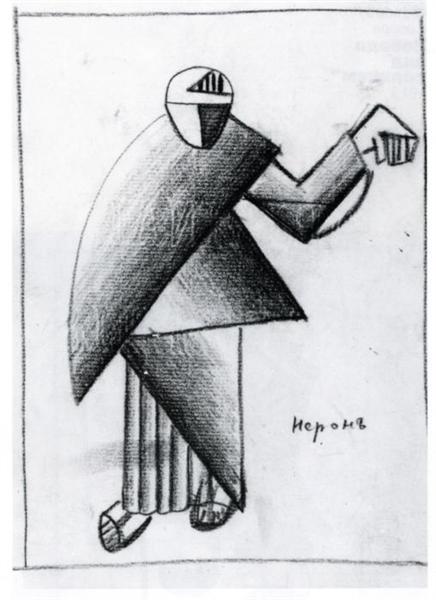Description
In the vast corpus of the work of Kazimir Malevich, Nero (1913) emerges as a fascinating piece that mixes the borders of Russian futurism and cubofuturism, combining a set of elements that reveal the convulsion and spirit of an era in full change. Malevich, mainly known for being the founder of suprematism, ventures here in a different but equally avant -garde territory, highlighting its versatility and ability to innovate.
Inspecting "Nero", we can appreciate a magnificent synthesis of classical iconography and avant -garde experimentation. No directly recognizable characters are found, but the work evokes an almost spectral presence of the human through its forms and colors. The reference to the Roman Emperor Nero is more conceptual than explicit, perhaps representing the idea of power, chaos and decay. Malevich uses a palette of vibrant and contrasting colors, predominantly the red, yellow and blue, which generate dynamism and an unmistakable visual drama.
The composition is characterized by its fragmented structure, with geometric shapes that intersect and overlap, evoking both cubism and futurism. These forms can be interpreted as a manifestation of the tumultuous and revolutionary spirit of the Russia of the early twentieth century, where the aesthetic and political categories were constantly blurred and rebuilt. Malevich, in its exploration of the decomposition and reconstruction of reality, invites us to reflect on the impermanence and fragmentation of human experience.
An intriguing aspect of "Nero" is its lack of traditional perspective. Instead of entering a conventional three -dimensionality, painting opts for a pictorial flatness that directs the viewer's gaze towards the very surface of the work. This pioneering approach is a precursor to the suprematist ideas that Malevich would develop more fully in later years, where the supremacy of pure sensation and complete abstraction take over.
The painting is in a limiting period for Malevich, when his work is still in transition towards complete abstraction, and it is in these moments of change where we find some of his most intriguing and provocative pieces. In a sense, "Nero" can be seen as a meditation on the destructive power of authority and the imminent dissolution of the ancient social and political orders, issues that resonate with a particular urgency in the context of prerevolutionary Russia.
When "Nero" looks, one cannot avoid feeling the energy and conflict of an era in crisis and revolution. Intense colors and bold forms of Malevich capture a world in transformation, a world where the boundaries between the old and the new, the orderly and the chaotic, are constantly negotiation. It is a work that, but perhaps less known than its suprematist compositions, offers an essential look at the artistic evolution and radical thinking of one of the greatest innovatives of modern art.
In conclusion, "Nero (1913)" is a powerful representation of a critical moment both in Malevich's artistic biography and in the history of European art. It is a work that not only reflects the aesthetic and political concerns of its time, but also anticipates the most radical developments that would come to redefine artistic practice in the twentieth century. The painting remains an evocative testimony of the ingenuity and boldness of Kazimir Malevich, an incessant visionary in his search for new ways of seeing and understanding the world.
KUADROS ©, a famous paint on your wall.
Hand-made oil painting reproductions, with the quality of professional artists and the distinctive seal of KUADROS ©.
Art reproduction service with satisfaction guarantee. If you are not completely satisfied with the replica of your painting, we refund your money 100%.

